Do Hawks Eat Blue Jays? – Everything You Need to Know!
Hawks and bluejays are iconic bird species often found in the same habitats. While hawks are known for their impressive hunting abilities, blue jays are known for their bright blue plumage and distinctive call. But what happens when these two species cross paths?
Yes, hawks eat bluejays. Hawks are known to be powerful predators, but their diet can vary depending on the species of hawk and the prey availability in their habitat. Some species of hawks, such as Cooper’s and sharp-shinned hawks, are known to prey on small to medium-sized birds, including bluejays.
This article will explore the predator-prey relationship between hawks and blue jays and the factors that affect hawk and bluejay relationships.
Hawk Species That Consume Blue Jays
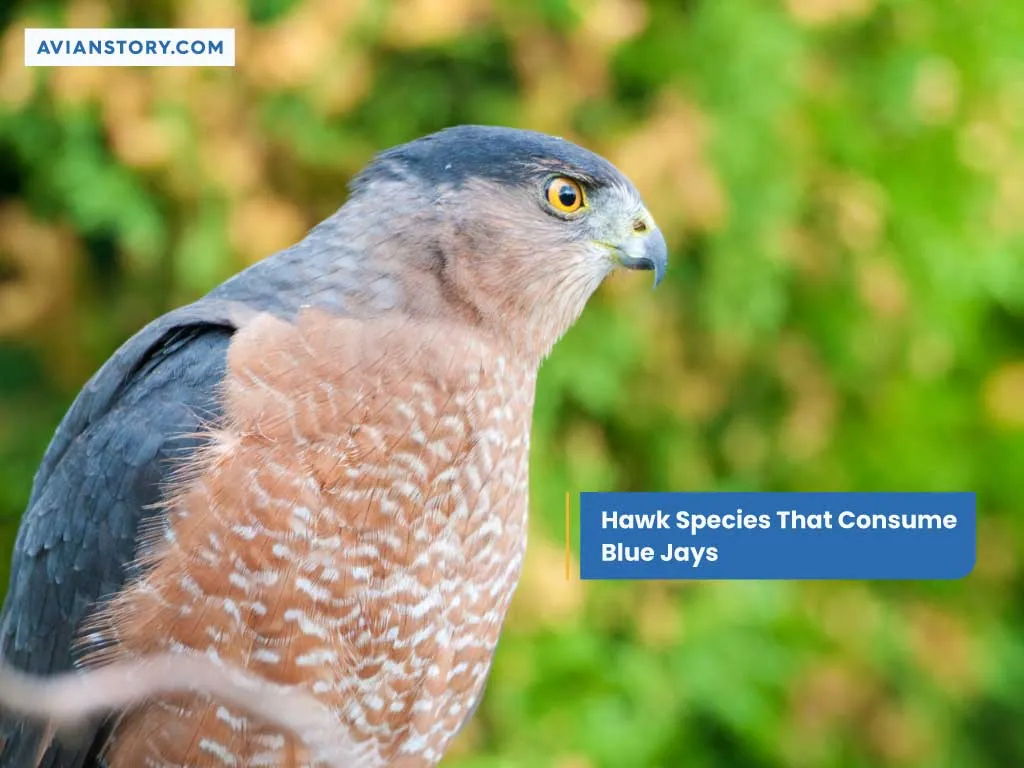
Hawks are members of the Accipitridae family, which includes eagles, kites, harriers, and other birds of prey. North America has over 30 species of hawks, each with unique physical characteristics and habitats. This brings us to the question, “What do hawks eat?”
Generally, hawks eat small mammals such as rodents, rabbits, squirrels, and other birds, reptiles, and insects. Cooper’s and sharp-shinned hawks are two hawk species observed eating blue jays. They are both small to medium-sized hawks with agile flight and the ability to maneuver through wooded areas.
Cooper’s Hawk
Cooper’s hawks (Accipiter cooperii) can be found across North America and are distinguished by their rounded tails and reddish-brown barring on their chests. They are approximately 14-20 inches in length, with a wingspan ranging from 24-35 inches.
Cooper’s hawks primarily feed on larger prey, such as rabbits and squirrels, but occasionally consume smaller prey. Blue jays are also eaten by Cooper’s hawk, especially in urban and suburban areas where they are more common.
Sharp-shinned Hawk
Sharp-shinned hawks (Accipiter striatus) resemble Cooper’s hawks in appearance but are slightly smaller in size and have a more square-shaped tail. They are approximately 9-13 inches long and have a wingspan of roughly 16-22 feet.
These hawks have blue-gray backs and wings, with horizontal white barring on the breast and belly. They are ambush predators that hunt small to medium-sized birds and have been observed preying on blue jays, like Cooper’s hawks.
Overview of Blue Jay (Cyanocitta cristata)
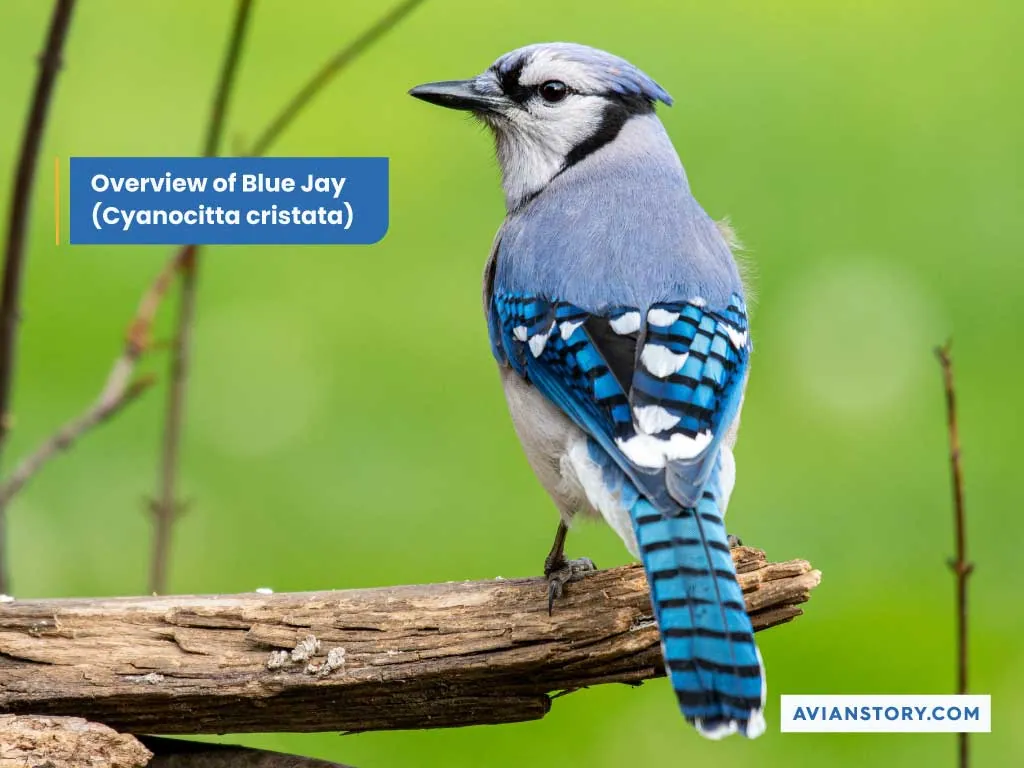
Blue jays (Cyanocitta cristata) are medium-sized birds easily recognizable due to their striking blue plumage.
Description And Characteristics
Blue jays have a wingspan of up to 17 inches (43 cm) and a length of 9-12 inches (23-30 cm). Their head, back, and wings are blue, with black markings on their face and crest, and a white underside with a black necklace.
Prominent black and white bars also distinguish their wings and tail feathers. They have a powerful, stout bill adapted to cracking open nuts and seeds. They also have powerful legs and feet for perching and climbing.
Habitat And Distribution
They are widespread in eastern and central North America, from Southern Canada to the Gulf of Mexico. They’re also common in suburban and urban areas and forested areas. They are year-round residents of their range and rarely migrate.
Diet And Behavior
Blue jays are omnivores with a diverse diet that includes insects, nuts, seeds, fruits, and, on rare occasions, small animals like frogs and mice. They have also been observed stealing eggs and young from other birds’ nests and scavenging for food in cities and suburbs.
They are vocal and social birds that use a variety of calls and songs to communicate with other jays and to establish territory. They are also known to be aggressive toward other birds and will vigorously defend their territory and food sources.
They are also well-known for their intelligence and problem-solving skills. They have been observed obtaining food with tools such as sticks and storing food for later use.
Why Do Blue Jays Mess With Hawks?
Blue jays are territorial birds that defend their nesting areas against all potential predators, including hawks. They may attempt to protect their young or defend their territory by mobbing and harassing predators such as hawks. Furthermore, they may use mobbing behavior to warn other potential prey species of nearby danger.
Factors Affecting Hawks’ Predation On Blue Jays
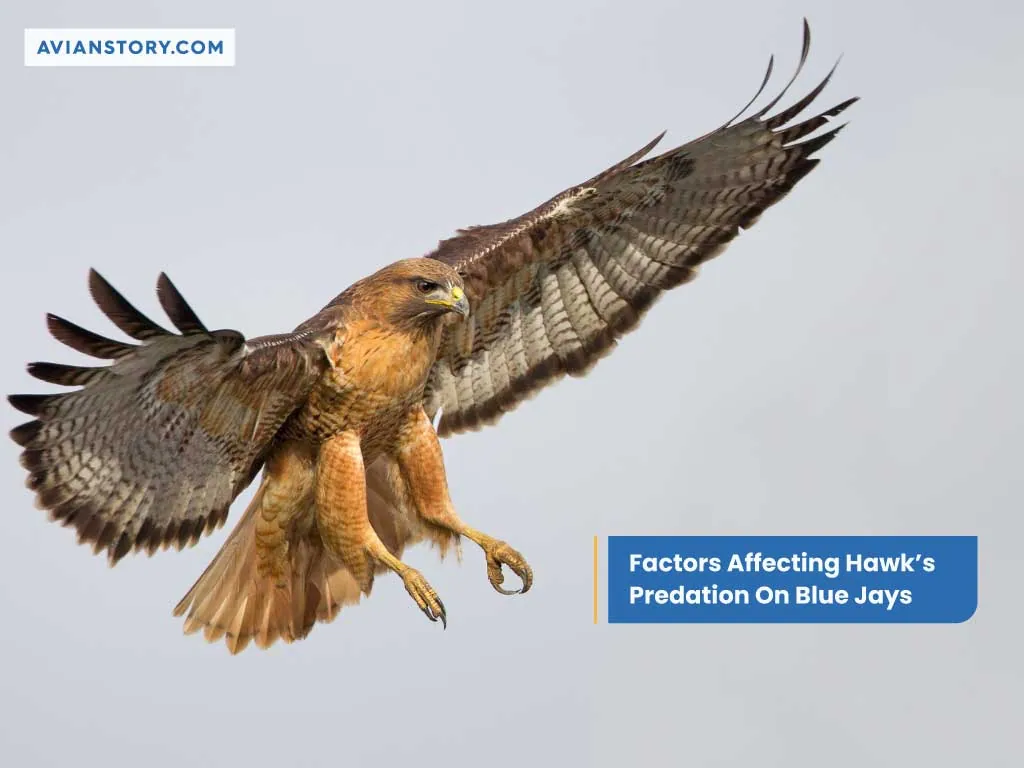
Several factors can affect hawks’ predation on blue jays, including:
Geographic Distribution And Habitat Overlap
Predation may be more likely in areas where the ranges of hawks and blue jays overlap, such as the eastern United States. Furthermore, the types of habitats that both species occupy can influence their chances of encountering each other.
Prey Availability
For example, suppose small birds or mammals are abundant in an area. In that case, hawks may focus on these easier and more abundant prey sources rather than expending energy on hunting jays, which are more challenging to catch. On the other hand, if other prey species are scarce, hawks may turn to blue jays as a food source.
Blue Jay Behavior And Vulnerability
Blue jays are known for being loud and conspicuous, which makes them easier to spot and catch for hawks. Furthermore, blue jays have been observed mobbing predators, which can be both a defensive behavior and a warning to other potential prey that danger is nearby.
This mobbing behavior, however, can make blue jays more conspicuous and easier for hawks to target.
Competition From Other Predators
Hawks are not the only predators in an ecosystem. Other animals, such as owls, snakes, and other birds of prey, may also hunt blue jays. In areas with a high concentration of predators, hawks may be less likely to target blue jays as prey to avoid competition with other animals.
Hunting Techniques For Capturing Blue Jays
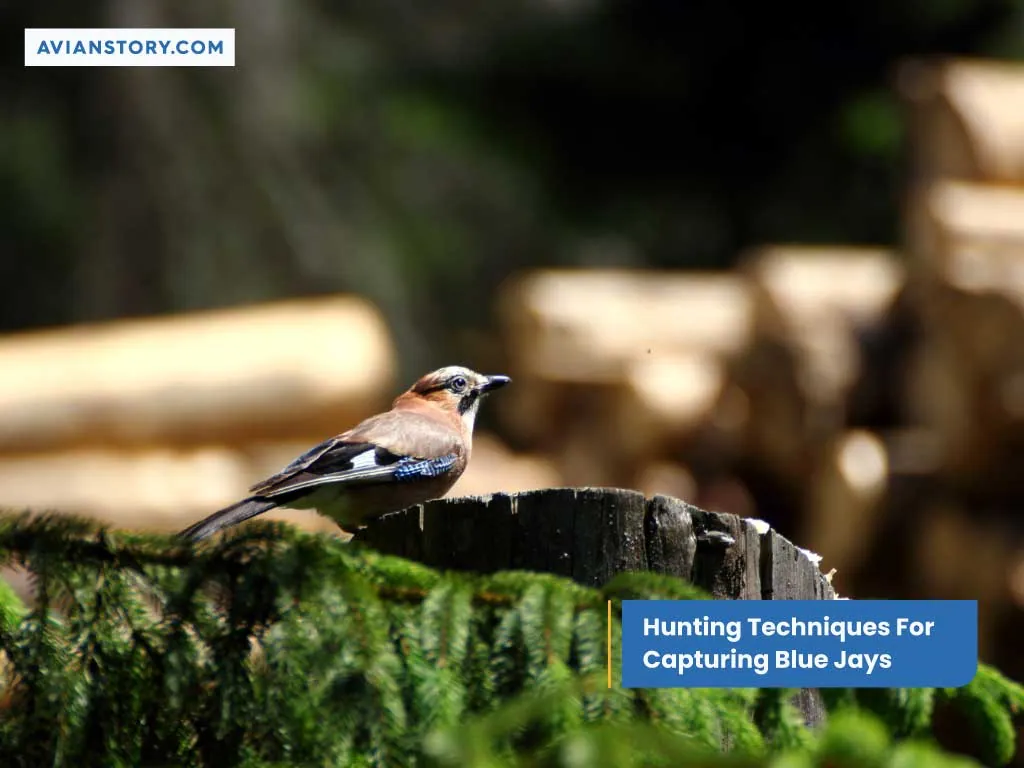
Here are some hunting techniques that hawks use to capture blue jays:
Perch Hunting
Perch hunting is where the hawk rests on a perch, such as a tree branch or a fence post, and watches for prey. When a blue jay approaches, the hawk will leap from its perch and attempt to catch the blue jay in mid-air.
Hawks can gauge the distance and speed of their prey with great precision, allowing them to strike quickly and precisely.
Aerial Attacks
Hawks also use aerial strikes as a hunting method. The hawk will fly high in the sky and watch for its prey below. When a blue jay is seen, the hawk will swoop down from above and seize it in mid-flight with its talons.
Cooperative Hunting
Hawks will occasionally engage in cooperative hunting with other hawks. This method is most effective when hunting larger game, such as rabbits or squirrels, but it can also be employed to catch blue jays.
In cooperative hunting, one hawk flushes out the prey while another hawk waits nearby to catch it.
Adaptations For Capturing And Consuming Blue Jays
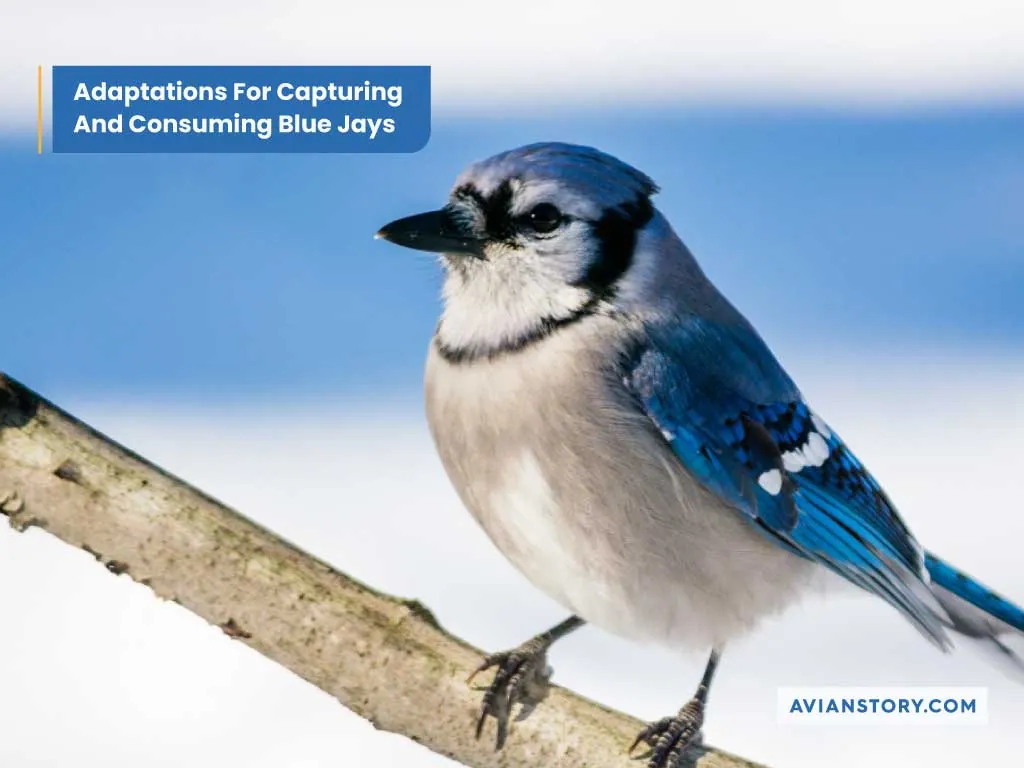
Here are some of the key adaptations that hawks use to hunt bluejays:
1. Sharp Talons
Hawks have strong, sharp talons designed to grip and hold onto prey. These talons are used to capture and immobilize prey, including bluejays. The talons also tear apart prey so the hawk can consume it more easily.
2. Powerful Beak
Hawks have a hooked beak that is designed to tear apart prey. The beak is sharp and powerful and is used to dismember prey into small, bite-sized pieces that the hawk can consume.
3. Excellent Eyesight
Hawks have impeccable eyesight, which allows them to locate and track prey from great distances. Hawks can spot blue jays from hundreds of feet away, and track their movements as they fly or move through the trees.
4. Agile Flight
Hawks are highly maneuverable in the air, and can easily fly through the trees and around obstacles. This allows them to chase after prey, including blue jays, and catch them in mid-air.
5. Stealth And Camouflage
Hawks can also use their natural camouflage and stealth to get close to prey without being detected. This allows them to surprise blue jays and other prey species, making it more difficult for the prey to escape.
Impact Of Blue Jay Consumption On Ecosystems

Here are some of the key ways in which the predation of blue jays can affect ecosystems:
1. Population Dynamics
The predation of blue jays can directly impact the population dynamics of both blue jays and their predators. If blue jays are an important prey species for hawks in a particular area, then fluctuations in blue jay populations can also affect the population dynamics of the hawks.
Similarly, blue jay populations may increase if hawk populations decline due to other factors.
2. Role In Seed Dispersal And Forest Regeneration
Blue jays are essential seed dispersers in many ecosystems, as they eat various fruits and berries and then disperse the seeds through their droppings.
If blue jay populations decline due to predation, then this can indirectly impact the distribution and abundance of plant species in the ecosystem.
3. Effects On Woodland Communities And Food Web Dynamics
Blue jays play critical roles in the ecosystems in which they live, such as seed dispersal and insect control. Their absence or reduction in numbers can impact the community composition of the woodland as well as the food web balance.
For example, if blue jay populations are reduced due to hawk predation, this can increase the populations of certain insects and plants that blue jays would usually control or disperse.
This can impact the populations of other organisms that rely on those insects or plants, resulting in broader effects on the ecosystem’s food web dynamics.
Human Impact On Hawks’ Blue Jay Predation
Human impact on hawks’ blue jay predation can occur in various ways. Here are some ways in which humans can affect the predation of blue jays by hawks:
Habitat Loss And Fragmentation
The destruction and fragmentation of forests, woodlands, and other habitats can limit the availability of suitable nesting sites and foraging areas for both hawks and blue jays. This can cause population declines and limit hawk predation on blue jays.
Human Interference With Nesting Sites
Hawks require undisturbed nesting sites, and human interference with these sites can cause them to abandon their nests or reduce their reproductive success. This may affect the hawk population and reduce the occurrence of blue jay predation.
Pesticide Use
Using pesticides and other chemicals in agriculture and landscaping can reduce the abundance of insects and other prey species that both hawks and blue jays rely on. This can lead to a decline in their populations and limit the opportunities for hawk predation on blue jays.
Climate Change
Climate change can impact the availability of suitable habitats and food resources for hawks and blue jays. Changes in temperature and weather patterns can alter the timing and abundance of prey species, potentially affecting the occurrence of blue jay predation.
Here are other related questions about the Hawks and blue jays.
-
Do hawks eat baby blue jays?
If given the chance, hawks will eat baby blue jays. Baby birds are prey for hawks, known to prey on various bird species. Baby birds’ vulnerability can make them an appealing target for hawks, especially if the nest is easily accessible.
-
Do hawks eat blue jay eggs?
Yes, hawks will eat blue jay eggs if given the opportunity. The eggs are a nutritious food source for hawks, and their vulnerability makes them an easy target. Hawks may prey on the eggs and the young jays.
-
Do blue jays scare off Hawks?
Blue jays are known for their aggressive nature, and they will not hesitate to confront and harass predators who approach their nesting areas. They may sometimes be successful in scaring off hawks or other predators.
Wrapping Up
Hawks eat blue jays; they are optimistic hunters and will eat anything they come to. Cooper and Sharp-shinned hawks are the most notorious blue jay predators. Blue jays are aggressive birds and will defend themselves against threats. This trait makes them a target for hawks.
Despite the predatory relationship between hawks and bluejays, both birds are essential parts of the ecosystem and play vital roles in maintaining a healthy and balanced environment. As such, we must protect both species and their habitats.
Conservation efforts, such as habitat restoration and public education, can help protect blue jays and other bird species from habitat loss, pollution, and climate change threats.
Resources:
- http://datazone.birdlife.org/species/factsheet/22695656
- https://www.allaboutbirds.org/news/sometimes-i-see-little-birds-going-after-a-big-bird-why-do-they-do-this/
